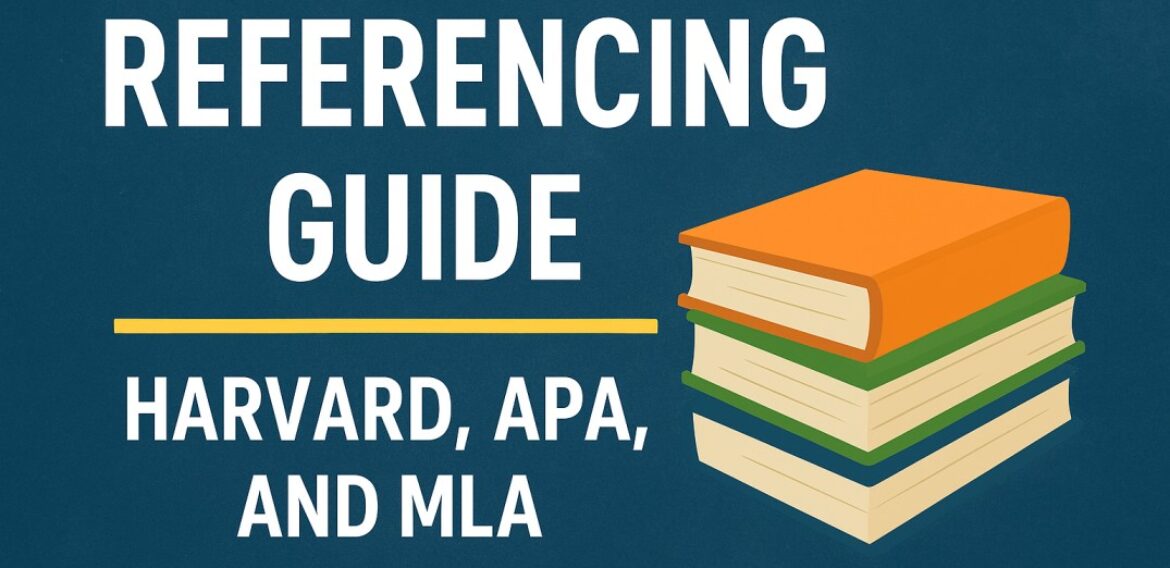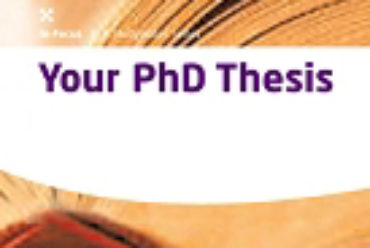Best referencing styles for UK universities (Harvard, APA, MLA)
What is referencing?
Referencing is the practice of acknowledging the sources of information, ideas, and evidence that you use in your academic work. It shows where your information comes from, whether it’s a book, journal article, website, or media source.
Example:
If you write “Climate change is largely driven by human activities such as burning fossil fuels” and this idea comes from a book by Smith (2020), you would reference it like this:
-
In-text citation (Harvard): (Smith, 2020)
-
Reference list: Smith, J. (2020). Climate Change and Society. Oxford University Press.
Why do universities require it?
Universities require referencing because it:
-
Gives credit to original authors and researchers.
-
Strengthens your argument by showing evidence from reliable sources.
-
Allows readers to check your sources for further study.
-
Promotes academic honesty and avoids plagiarism.
-
Develops critical thinking by encouraging engagement with scholarly work.
Consequences of poor referencing
Failing to reference correctly can lead to academic misconduct. Universities take this very seriously, with possible consequences:
| Issue | Example | Consequence |
|---|---|---|
| Plagiarism | Copying a paragraph from an article without citation. | Marked as academic dishonesty → zero marks, disciplinary action. |
| Grade penalties | Incorrect or inconsistent references. | Lower grades due to “poor academic practice.” |
| Loss of credibility | Using weak or unattributed sources. | Work may be dismissed as unreliable. |
| Severe misconduct | Submitting an essay with large unreferenced sections. | Possible failure of course or expulsion (for repeated cases). |
✅ This section sets the foundation clearly with definitions, reasons, and consequences supported by examples and a table.
Core Concepts of Referencing
In-text citation vs. Reference list / Works Cited
-
In-text citation: A short reference inside your essay that points the reader to the full source in your reference list.
-
Example (Harvard): (Brown, 2019)
-
Example (APA): (Brown, 2019, p. 45)
-
Example (MLA): (Brown 45)
-
-
Reference list / Works Cited: A full list of all sources cited in your work, usually at the end of the essay.
-
Example (Harvard): Brown, T. (2019). Modern History in Context. Cambridge University Press.
-
Example (MLA): Brown, Tom. Modern History in Context. Cambridge University Press, 2019.
-
Primary referencing systems
| System | Used in | In-text style | Example |
|---|---|---|---|
| Author–Date (Harvard, APA) | Sciences, social sciences, business, education | Author’s surname + year | (Smith, 2020) |
| Author–Page (MLA) | Humanities, literature, arts | Author’s surname + page number | (Smith 45) |
Common elements in a reference
Regardless of the style, most references contain similar information:
| Element | Meaning | Example |
|---|---|---|
| Author | Who wrote/produced the work | Smith, J. |
| Year | When it was published | 2020 |
| Title | The name of the book/article/webpage | Climate Change and Society |
| Publisher | Organisation that published the work | Oxford University Press |
| Place of publication (sometimes required) | City of publication | Oxford |
| DOI/URL | Digital link to online material | https://doi.org/10.1016/j.clim.2020.03.005 |
📌 Quick Example (Harvard style reference for an online journal article):
-
In-text: (Williams, 2021)
-
Reference list: Williams, R. (2021). ‘Urban planning and climate resilience’, Journal of Environmental Policy, 12(3), pp. 45–62. doi:10.1080/13563475.2021.0045.
Harvard Referencing (Most Common in the UK)
Harvard referencing is one of the most widely used styles in UK universities. It is especially common in business, economics, social sciences, and engineering. The system is based on the Author–Date method, where short citations in the text point the reader to full references listed at the end of the document.
In-text citations
In-text citations in Harvard are simple and include the author’s surname and the year of publication. When quoting directly, a page number is added.
-
One author: (Smith, 2020)
-
Two authors: (Smith and Jones, 2019)
-
Three or more authors: (Smith et al., 2018)
-
Direct quote: “Global warming is the greatest challenge of our time” (Smith, 2020, p. 45).
-
Paraphrase: Smith (2020) argues that global warming is one of today’s biggest challenges.
-
Multiple sources: (Smith, 2020; Brown, 2018; Patel, 2017)
Reference list
At the end of the essay, all sources are listed alphabetically by the author’s surname. Harvard references usually include: author, year, title (in italics for books/journals), edition (if relevant), place of publication, and publisher.
Examples:
-
Book: Brown, T. (2019). Modern history in context. Cambridge: Cambridge University Press.
-
E-book: Green, L. (2021). Digital education [e-book]. Routledge.
-
Journal article: Taylor, P. (2020). ‘Climate policy and urban resilience’, Environmental Studies Journal, 15(2), pp. 123–140.
-
Website: WHO (2021). Climate change and health.
-
Report: Department for Education (2020). Higher education statistics 2019–2020. London: DfE.
-
Podcast: BBC (2022). The climate debate [Podcast].
Harvard is generally seen as straightforward and flexible, but consistency is important. Every in-text citation must match a full entry in the reference list.
APA Referencing (Common in Psychology & Social Sciences)
APA (American Psychological Association) referencing is most commonly used in psychology, education, and other social sciences. Like Harvard, it follows the Author–Date system, but APA is more detailed and standardised, with clear rules about punctuation, capitalization, and formatting.
Are you having trouble understanding referencing in your dissertation? Academic writers uk is here to help you.
We are the best Academic writing service provider in the uk. Contact us on our whatsapp for free consultation regarding your quesries!
In-text citations
APA in-text citations are similar to Harvard but have some important differences:
-
One author: (Smith, 2020)
-
Two authors: (Smith & Jones, 2019) — note the ampersand (&) instead of “and”.
-
Three or more authors: (Smith et al., 2018) — APA uses et al. from the first citation.
-
Direct quote: “Global warming is the greatest challenge of our time” (Smith, 2020, p. 45).
-
Quoting from a webpage without page numbers: (WHO, 2021, para. 4)
-
Paraphrasing: Smith (2020) suggests that global warming is one of the greatest challenges today.
Reference list
The reference list in APA is titled “References” and each entry has a hanging indent. APA is stricter than Harvard about the use of italics and capital letters:
-
Only the first word of titles (and proper nouns) is capitalized in book and article titles.
-
Journal titles keep full capitalization.
-
DOIs are preferred for journal articles, but if unavailable, just the journal and page numbers are given.
Examples:
-
Book: Brown, T. (2019). Modern history in context. Cambridge University Press.
-
Journal article: Taylor, P. (2020). Climate policy and urban resilience. Environmental Studies Journal, 15(2), 123–140.
-
Website: World Health Organization. (2021, June 10). Climate change and health.
-
Conference paper: Patel, R. (2021). Smart cities and climate adaptation. In L. Roberts (Ed.), Proceedings of the International Conference on Urban Sustainability (pp. 56–70). Springer.
-
Dataset: NASA. (2020). Global climate data 2000–2020 [Data set]. NASA EarthData.
APA is valued for its clarity and consistency, especially in the social sciences, where precision and standardization are important.
MLA Referencing (Used in Humanities/Arts)
MLA (Modern Language Association) referencing is most commonly used in the humanities, especially in literature, history, philosophy, and the arts. Unlike Harvard and APA, MLA does not emphasise the publication year. Instead, it uses the Author–Page system, which highlights the page number of the source being cited. This makes it especially useful in disciplines where the exact passage of a text is important, such as when quoting novels, plays, or poems.
In-text citations
In MLA style, the author’s surname and page number appear in parentheses. There is no comma between the name and the page number, and the year is not included.
-
One author: (Smith 45)
-
Two authors: (Smith and Jones 89)
-
Three or more authors: (Smith et al. 102)
-
Direct quotation: “Global warming is the greatest challenge of our time” (Smith 45).
-
Paraphrasing: Smith argues that global warming is one of today’s greatest challenges (45).
-
Classic works: For Shakespeare, the standard is play, act, scene, line → (Shakespeare, Hamlet 3.1.55–60).
Works Cited list
Instead of a “References” list, MLA uses a “Works Cited” page. All entries are arranged alphabetically by author and use hanging indents. Titles of books and journals are italicised, while article and webpage titles appear in quotation marks. Unlike APA and Harvard, the full first name of the author is usually given.
Examples:
-
Book: Brown, Tom. Modern History in Context. Cambridge University Press, 2019.
-
Journal article: Taylor, Paul. “Climate Policy and Urban Resilience.” Environmental Studies Journal, vol. 15, no. 2, 2020, pp. 123–140.
-
Website: World Health Organization. “Climate Change and Health.” WHO, 2021.
-
Film: Inception. Directed by Christopher Nolan, Warner Bros., 2010.
-
Edited collection: Patel, Rohan. “Smart Cities and Climate Adaptation.” Urban Futures: Essays in Sustainability, edited by Laura Roberts, Springer, 2021, pp. 56–70.
MLA’s strength lies in its simplicity and focus on texts rather than publication details. It is particularly suitable when citing literary and cultural works, where page numbers are more meaningful than years of publication.
Key Differences Between Harvard, APA, and MLA
Although all three referencing systems aim to credit sources and avoid plagiarism, they differ in their focus, formatting, and style rules. Understanding these distinctions helps students apply the correct method for their subject area.
Main formatting differences
-
Harvard: Focuses on author and year; widely used in the UK; flexible but must remain consistent.
-
APA: Focuses on author and year but has very strict formatting rules (capitalization, punctuation, italics, DOIs). Common in psychology and social sciences.
-
MLA: Focuses on author and page number; avoids publication years in citations. Preferred in humanities and arts.
In-text citation comparison
-
Harvard: (Smith, 2020, p. 45)
-
APA: (Smith, 2020, p. 45) — same as Harvard but formatted differently in references.
-
MLA: (Smith 45) — no year, just author and page number.
Reference list vs. Works Cited vs. References
-
Harvard: Reference list (alphabetical by surname).
-
APA: References (strict rules, hanging indents, limited capitalization).
-
MLA: Works Cited (includes full first names, focuses on page numbers, titles often in quotation marks).
Example side-by-side
If citing the same book:
-
Harvard: Brown, T. (2019). Modern history in context. Cambridge: Cambridge University Press.
-
APA: Brown, T. (2019). Modern history in context. Cambridge University Press.
-
MLA: Brown, Tom. Modern History in Context. Cambridge University Press, 2019.
Practical Referencing Skills
Referencing is not only about memorising rules — it is also about applying them correctly in your own writing. Students often struggle with practical situations such as how to quote, paraphrase, or handle unusual sources.
Quoting vs. paraphrasing
-
Quoting: Use the exact words from a source, enclosed in quotation marks, and provide a page number.
-
Example (Harvard): “Global warming is the greatest challenge of our time” (Smith, 2020, p. 45).
-
-
Paraphrasing: Restate the idea in your own words while still giving credit to the author.
-
Example (Harvard): Smith (2020) argues that global warming is one of today’s biggest challenges.
-
Paraphrasing shows understanding and is usually preferred in academic writing, while quoting is useful for definitions, striking phrases, or literary analysis.
Secondary referencing
Sometimes you need to cite a source that is quoted inside another work. It is always better to find the original, but if that is not possible, you can use secondary referencing.
-
Example (Harvard): Freud’s theories were later challenged (cited in Jones, 2018, p. 76).
Multiple works by the same author in the same year
When one author has written several works in the same year, you can distinguish them using letters (a, b, c).
-
Example: (Smith, 2020a), (Smith, 2020b)
-
Reference list:
-
Smith, J. (2020a). Climate and society. Routledge.
-
Smith, J. (2020b). Environmental futures. Palgrave.
-
Citing organisations instead of authors
When a report or webpage is produced by an organisation rather than an individual, the organization is treated as the author.
-
Example (Harvard): (World Health Organization, 2021)
-
Reference list: World Health Organization (2021). Climate change and health.
Tools & Resources
Referencing can be time-consuming, but there are many tools and resources that can make the process easier. Universities usually provide their own guides, but students can also make use of standard references and digital tools.
University referencing guides
Most universities publish online referencing handbooks with clear examples. Always check your own institution’s rules, as small variations exist (especially in Harvard style).
Cite Them Right (UK standard)
The book Cite Them Right by Pears and Shields is the most widely recommended UK guide to referencing. Many UK universities require students to follow its Harvard format.
Reference managers
Software tools can help store and format references automatically:
-
Zotero – free, open-source tool for managing sources.
-
Mendeley – useful for research collaboration and PDF management.
-
EndNote – widely used in professional and research environments.
Quick citation generators
Websites like CiteThisForMe or EasyBib allow students to generate references quickly. However, they can sometimes produce errors, so it is important to double-check formatting against official guides.
Practice & Exercises
The best way to master referencing is through practice. Students can try exercises such as reformatting citations, identifying mistakes, or building reference lists for their own essays.
Example exercises
-
Rewrite a source in three styles:
Suppose you use the book Modern History in Context by Tom Brown, published in 2019 by Cambridge University Press.-
Harvard: Brown, T. (2019). Modern history in context. Cambridge: Cambridge University Press.
-
APA: Brown, T. (2019). Modern history in context. Cambridge University Press.
-
MLA: Brown, Tom. Modern History in Context. Cambridge University Press, 2019.
-
-
Spot the mistakes:
Compare the following citation to the correct one above:Brown T (2019) Modern History Context. Cambridge.
Mistakes include: missing italics, missing publisher name, incorrect punctuation, and incomplete details. -
Build your own reference list:
Take a short essay you have written and create a full reference list. Check:-
Are all in-text citations included in the list?
-
Are they in the correct alphabetical order?
-
Is the punctuation and italics consistent?
-
By practising regularly, you will become confident and efficient in applying the correct referencing system.






